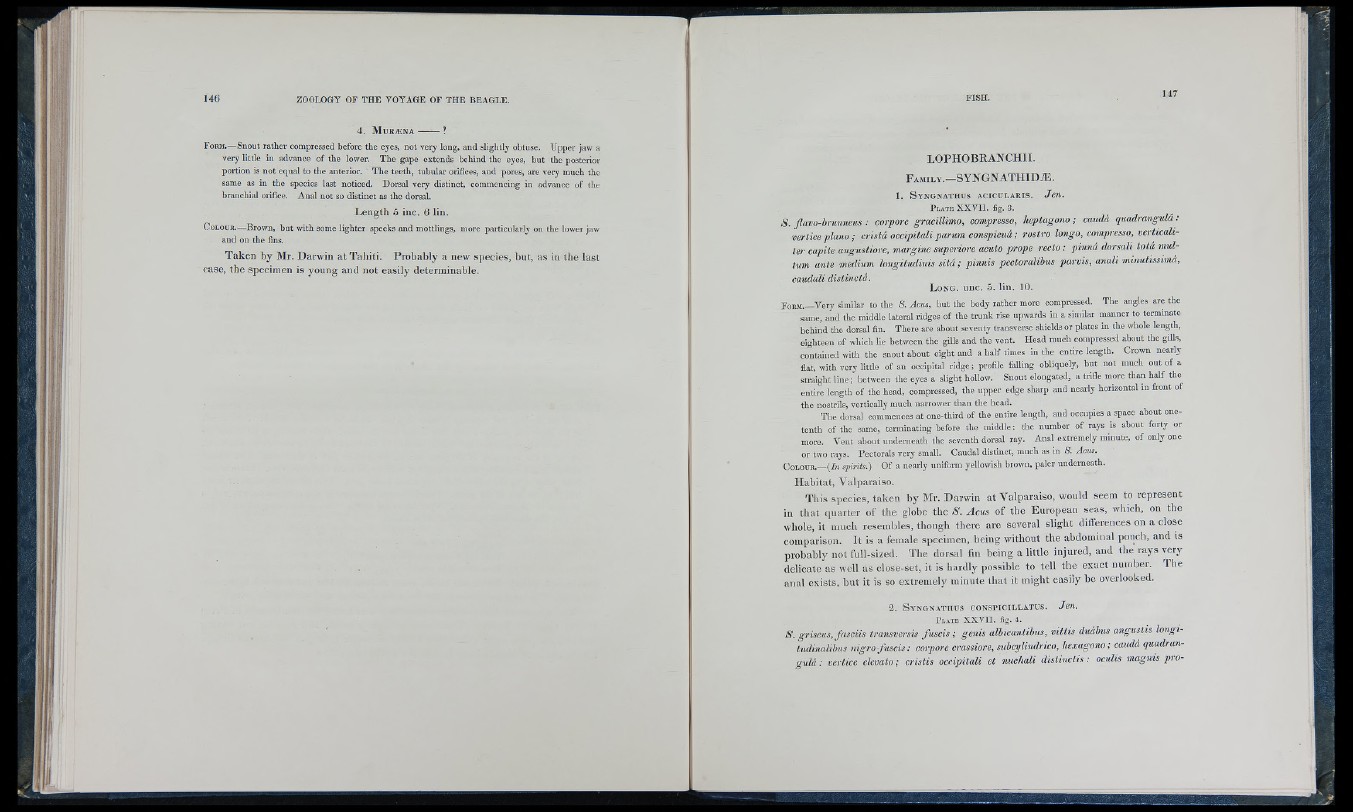
4. MuRjENA -
F o rm .— Snout rather compressed before the eyes, not very long, and slightly obtuse. U pper jaw a
very little in advance of the lower. T he gape extends behind the eyes, but tlie posterior
portion is not equal to the anterior. T he teeth, tubular orifices, and pores, are very much the
same as in the species last noticed. Dorsal very distinct, commencing in advance of the
branchial orifice. Anal not so distinct as the dorsal.
Length 5 inc. 6 lin.
UoLOU R.— B ro w n , h u t w ith s o m e lig h te r s p e c k s a n d m o ttlin g s , m o r e p a r tic u la r ly o n th o lo w e r ja w
a n d o n th e fin s.
Taken by Mr. Darwin at Tahiti. Probably a new species, but, as in the last
case, the specimen is young and not easily determinable.
LOPHOBRANCHII.
F amily.-S Y N G N A T H ID ^ .
1 . S y n g n a t h u s a c i c u l a r i s . Jen.
P l a t e X X V II. f i g . 3 .
S . Jiavo-hm nneus : corpore gracilUmo, compresso, heptágono ; caudá quadrangulà :
vertice plano ; cristà occipitali parum conspicuà; rostro longo, compresso, verticali-
ter capite angustiare, margine superiore acuto prope recto: pinnà dorsali totà mul-
tum ante medium longitudinis sità ; pinnis pectoralibus parvis, a n a l i m inutissima,
caudali dislinctà.
L o n g . unc. 5. lin. 10.
F o r m . — Very similar to the 8. Acus, but the body rather more compressed. T he angles are the
same, and the middle lateral ridges of the trunk rise upwards in a similar manner to terminate
behind the dorsal fin. There are about seventy transverse shields or plates in the whole length,
eighteen of which lie between the gills and the vent. H ead much compressed about the gills,
contained with the snout about eight and a half times in the entire length. Crown nearly
flat, with very little of an occipital ridge ; profile falling obliquely, but not much out of a
straight line; between the eyes a slight hollow. Snout elongated, a trifle more than half the
entire length of the head, compressed, the upper edge sharp and nearly horizontal in front of
the nostrils, vertically much narrower than the head.
T he dorsal commences at one-third of the entire length, and occupies a space about one-
tenth of the same, terminating before the m iddle: the num ber of rays is about forty or
more. V ent about underneath the seventh dorsal ray. Anal extremely minute, of only one
or two rays. Pectorals very small. Caudal distinct, much as in S. Acus.
C o l o u r .— (Jii sjjirits.) O f a nearly uniform yellowish brown, paler underneath.
H abitat, Valparaiso.
This species, taken by IMr. Darwin at Valparaiso, would seem to represent
in that quarter of the globe the S . A cus of the European seas, which, on the
whole, it much resembles, though there are several slight differences on a close
comparison. It is a female specimen, being without the abdominal pouch, and is
probably not fnll-sized. Tlie dorsal fin being a little injured, and the rays very
delicate as well as close-set, it is hardly possible to tell the exact number. The
anal exists, but it is so extremely minute that it might easily be overlooked.
2 . S y n g n a t h u s c o n s p i c i l l a t u s . Jen.
P l a t e X X V I I . f i g . 4 .
S . griseus, fa sciis transversis fu scis ; genis albicaniibus, v ittis duàhus angustis longitudinalibus
nigro fu scis : corpore crassiore, subcylindrico, hexágono; caudá quadran-
o'ulá: vertice elevato; cristis occipitali et nuchali distinclis : oculis m agnis pro-
SB